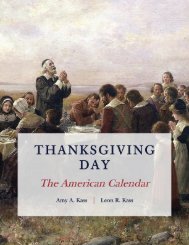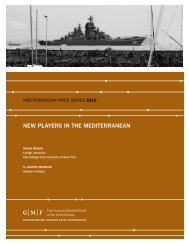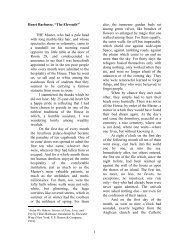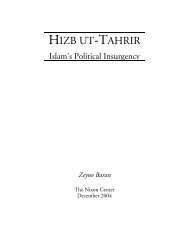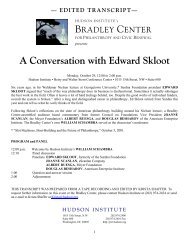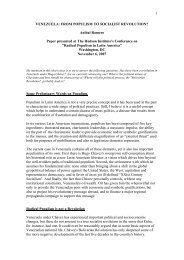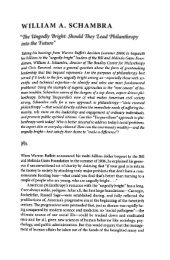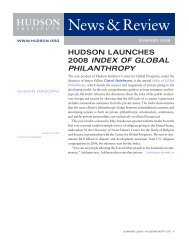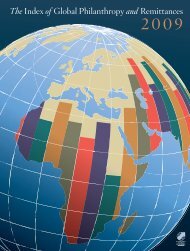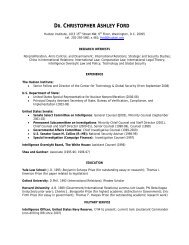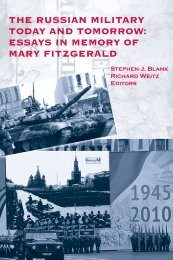Saudi Arabia's Curriculum of Intolerance - Hudson Institute
Saudi Arabia's Curriculum of Intolerance - Hudson Institute
Saudi Arabia's Curriculum of Intolerance - Hudson Institute
You also want an ePaper? Increase the reach of your titles
YUMPU automatically turns print PDFs into web optimized ePapers that Google loves.
30<br />
EDUCATIONAL REFORM IS CRITICAL:<br />
<strong>Saudi</strong> Arabia’s Global Influence<br />
A century ago, <strong>Saudi</strong> Arabia was sparsely populated with nomadic tribes who were not yet<br />
united into a recognized nation. With relative suddenness, it has emerged from subsistence living<br />
and obscurity to become a wealthy regional power, and an influential leader within the Muslim<br />
world. Yet, its public educational system, reflecting its governing ideology, remains rooted in the<br />
blend <strong>of</strong> the harsh desert traditions and severe Islamic interpretations <strong>of</strong> its past.<br />
The origins <strong>of</strong> the modern <strong>Saudi</strong> regime lie in the partnership forged in the eighteenth century<br />
between Muhammad bin Saud, founder <strong>of</strong> the modern-day <strong>Saudi</strong> dynasty, and Abd al-Wahhab, a<br />
fundamentalist Muslim scholar. An extreme <strong>of</strong>fshoot <strong>of</strong> Islam’s Hanbali school, Wahhab’s<br />
thought is based on a dualistic worldview in which true “monotheists” are obliged until judgment<br />
day to “fight” “polytheists” and “idolaters,” including Christians, Jews, Shiites, and<br />
insufficiently zealous Sunni Muslims. It was made the ruling ideology and the underlying<br />
philosophy <strong>of</strong> the sharia or law in the regions <strong>of</strong> Arabia under <strong>Saudi</strong> control. In the early<br />
twentieth century, <strong>Saudi</strong> leader Abdulaziz al-Saud (Ibn Saud) unified the disparate tribes in the<br />
Arabian Peninsula, mainly through conquest. The Hejaz, encompassing Mecca and Medina, was<br />
among the areas that fell under <strong>Saudi</strong> control. In 1926, Ibn Saud convened a global Islamic<br />
conference to affirm his position as guardian <strong>of</strong> the two holiest shrines in Islam. In 1932, the<br />
current <strong>Saudi</strong> state <strong>of</strong>ficially emerged, keeping intact the close relationship between the <strong>Saudi</strong><br />
ruling family and the al Sheikh family, the hereditary leaders <strong>of</strong> the Wahhabi religious<br />
establishment. The final element that would complete the definition <strong>of</strong> modern-day <strong>Saudi</strong> Arabia<br />
was put in place in 1945, when Ibn Saud met with American President Franklin D. Roosevelt to<br />
consolidate an economic alliance that his country had entered into a decade earlier with the<br />
American company Standard Oil. <strong>Saudi</strong> Arabia, it was to be discovered, has one quarter <strong>of</strong> the<br />
world’s proven oil reserves, a fact that has undergirded a U.S.-<strong>Saudi</strong> strategic alliance for the<br />
past sixty years. 84<br />
Governed on a monarchical model, <strong>Saudi</strong> Arabia defines itself today as an Islamic state. 85<br />
Religion and government remain interlocked. It has established Wahhabism as the <strong>of</strong>ficial state<br />
political ideology and the basis <strong>of</strong> jurisprudence for its sharia, 86 pays the salaries <strong>of</strong> the Wahhabi<br />
clerical establishment, and has elevated the <strong>of</strong>fice <strong>of</strong> Grand Mufti to a government cabinet-level<br />
position. 87<br />
Within <strong>Saudi</strong> Arabia, Muslims who openly disagree with Wahhabi rulings are denounced,<br />
discredited, and intimidated and may be <strong>of</strong>ficially punished for blasphemy or apostasy. Dissent<br />
from the state’s religious dogma can result in job loss or criminal prosecution. Political reformers<br />
who peacefully petitioned for rights through a constitutional monarchy were imprisoned for over<br />
a year for using “un-Islamic terminology,” and other <strong>of</strong>fenses. 88 Despite the presence <strong>of</strong> millions<br />
<strong>of</strong> non-Muslims and non-Wahhabi Muslims in the Kingdom, <strong>Saudi</strong> authorities forbid the public<br />
practice <strong>of</strong> non-Muslim religions and severely restrict the practices <strong>of</strong> Shi’a Muslims, including<br />
the Ismailis. 89<br />
<strong>Saudi</strong> Wahhabism is the core <strong>of</strong> the public school curriculum, comprising much or most <strong>of</strong> the<br />
school day through high school. Some five million <strong>Saudi</strong> students are educated with these



